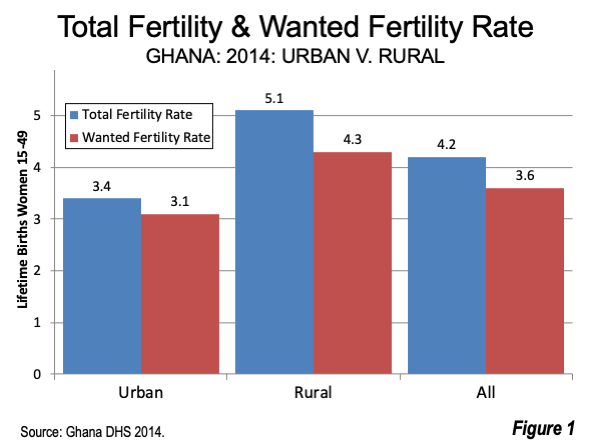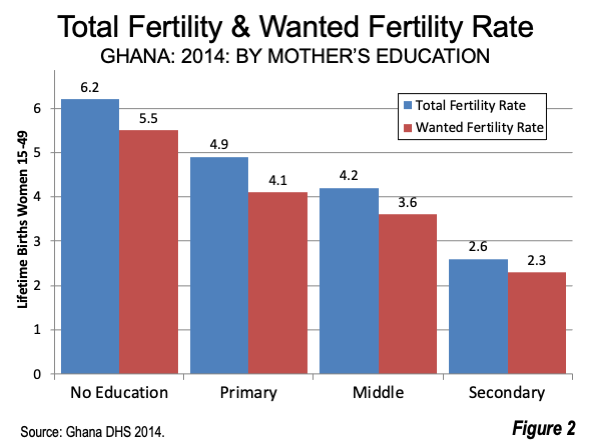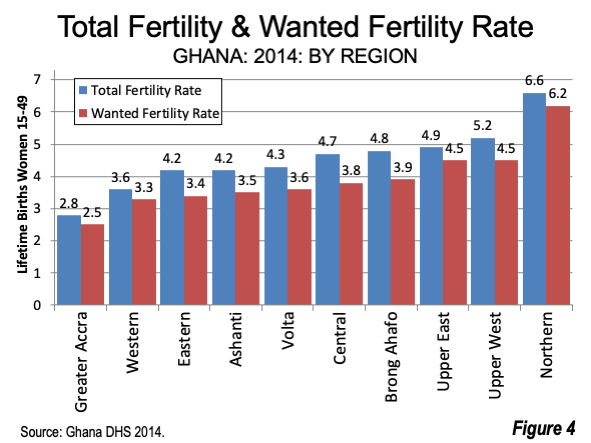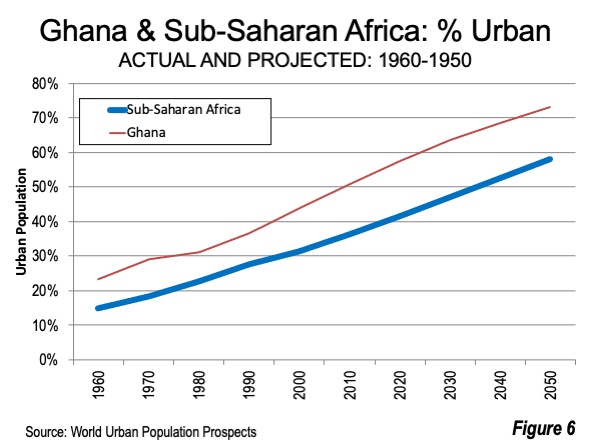
Sub-Saharan Africa has grown quickly, at a rate about 1.5 times the rest of the world from 1960 to 2020. This has principally been the result of its higher fertility rates and increasing life expectancy. According to the United Nations medium variant projection, more than 90% of the world’s population increase between 2020 and 2100 will occur in sub-Saharan Africa.
Fertility in Ghana
Ghana, which was the first sub-Saharan nation to win its independence after World War II (1957) exemplifies fertility and population trends in the area.
Ghana’s rising population and dropping fertility reflects trends seen in other sub-Saharan African countries. This article explores population growth and total fertility rates (TFRs) of Ghana over the last six decades, with projections to 2100. Detailed TFR data is from the US AID Demographic and Health Surveys Program (DHS), in cooperation with the Ghana Statistical Service and the Ghana Health Service.
The Ghana DHS 2014 report includes not only TFRs, but also “wanted fertility rates.” A wanted fertility rate above the actual could indicate that higher fertility rates are likely. Where the wanted fertility rate is lower than the actual, it could indicate a future of less fertility. This is the situation in Ghana with its prospect of lower fertility, a characteristic it shares with just about every other sub Saharan nation.
In 1960, Ghana’s Total Fertility Rate (TFR) was nearly seven, meaning that the average woman of child-bearing age had that many children live births in her lifetime. In 1960, Ghana had a population under 7 million, and more than quadrupled to 32 million in 2020.
National TFRs: Past and Projections
By 2014 Ghana’s TFR dropped to 4.2 children over the life of a mother. This compares to a lower 3.6 wanted fertility rate and, by indicating preferences felt by women, should lead to lower fertility rates in the future. This would be consistent with the declining TFR projections of both United Nations and Vienna’s Wittgenstein Centre for Demography and Global Human Capital. By 2100, the United Nations medium variant projects a Ghana TFR of 1.9, while the Wittgenstein Centre projects 1.7, both below replacement rate (Figure 1). This difference in TFRs would produce materially different populations, with 73 million projected by the United Nations and 61 million by the Wittgenstein. The Wittgenstein Centre TFR for Ghana in 2100 would be virtually equal to that of the United States today.

Urban and Rural TFRs
Urbanization is a key factor in making these predictions. Ghana’s population has become substantially much more concentrated in urban areas over the past six decades, rising 23% in 1960 to 57% in 2020, according to the United Nations (Figure 2).

Generally, higher TFRs are associated with greater urbanization, as is the case in Ghana. Ghana‘s urban TFR in 2014 was 3.4. This, however, is higher than the wanted TFR of 3.1 for urban women. Ghana’s rural TFR is considerably higher, at 5.1, well above the 4.3 wanted fertility rate for rural women (Figure 3).

TFR’s by Education
Lower fertility is associated with higher levels of education at the national level.
Among women with secondary and greater education, the TFR is 2.6, above the wanted TFR of 2.3. For those with middle school education, the CFR rises to 4.2, compared to the 3.6 wanted TFR. For those with primary education, the TFR is 4.9 compared to the 4.1 wanted fertility rate. And, for those with no education the TFR is 6.2, compared to the 5.5 wanted TFR. Among those with greater education TFR is nearly 60 percent below that of those with no education.(Figure 4).

Fertility by Wealth
Lower TFR‘s are also correlated with higher incomes, also at the national level.
Among the highest wealth quintile household wealth quintile, the TFR in 2014 for Ghana was 2.8, compared to a wanted TFR of 2.6.The TFR rises in the intermediate wealth quintiles, reaching a peak of 6.3 in the lowest quintile, which is well above the 5.5 wanted fertility rate in the same category (Figure 5).

Fertility by Region
As shown above, TFRs tend lower with greater urbanization. This is apparent in the regional data. Data is provided for 10 regions in Ghana, with by far the lowest TFR in Greater Accra, at 2.8, compared to a wanted TFR of 2.5. Greater Accra has a population density nearly six times that of the Central region, which is the second most densely populated part of the country. Greater Accra has the nation’s capital and its urban area has about 5.5 million residents. The TFR of Kumasi, the second largest urban area (over 4 million) is masked by the much greater rural share of the population in its Ashanti region (Figure 6).

Prospects
It is notable that in each of the dimensions measured in Figures 3 through 6, the wanted TFR is lower than the actual TFR. The Wittgenstein Centre projections for 2100 TFR and population are materially below those of the United Nations but reflect the same tendencies. The difference between the UN and Wittgenstein Centre TFRs, according to founding director Wolfgang Lutz, are assumed improvements in female education and related employment gains. These TFR reductions, whether from the UN or the Wittgenstein Centre will require continued economic progress to be achieved.
Wendell Cox is principal of Demographia, an international public policy firm located in the St. Louis metropolitan area. He is a founding senior fellow at the Urban Reform Institute, Houston, a Senior Fellow with the Frontier Centre for Public Policy in Winnipeg and a member of the Advisory Board of the Center for Demographics and Policy at Chapman University in Orange, California. He has served as a visiting professor at the Conservatoire National des Arts et Metiers in Paris. His principal interests are economics, poverty alleviation, demographics, urban policy and transport. He is co-author of the annual Demographia International Housing Affordability Survey and author of Demographia World Urban Areas.
Mayor Tom Bradley appointed him to three terms on the Los Angeles County Transportation Commission (1977-1985) and Speaker of the House Newt Gingrich appointed him to the Amtrak Reform Council, to complete the unexpired term of New Jersey Governor Christine Todd Whitman (1999-2002). He is author of War on the Dream: How Anti-Sprawl Policy Threatens the Quality of Life and Toward More Prosperous Cities: A Framing Essay on Urban Areas, Transport, Planning and the Dimensions of Sustainability.
Photo: Flag of Ghana.













Niger
From today's Financial Times: News in-depth. Niger questions wisdom of sustaining world’s highest birth rate